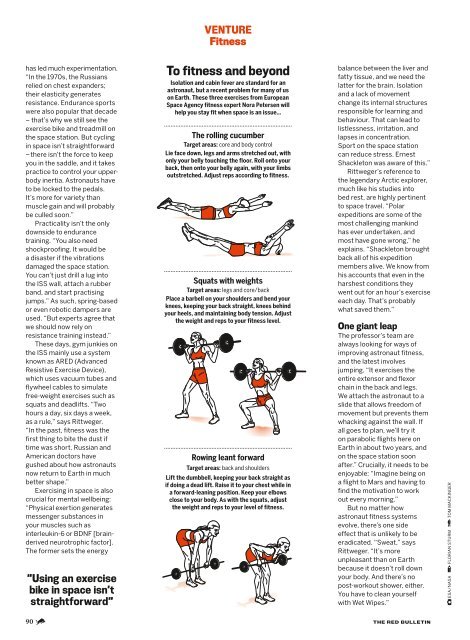You also want an ePaper? Increase the reach of your titles
YUMPU automatically turns print PDFs into web optimized ePapers that Google loves.
VENTURE<br />
Fitness<br />
has led much experimentation.<br />
“In the 1970s, the Russians<br />
relied on chest expanders;<br />
their elasticity generates<br />
resistance. Endurance sports<br />
were also popular that decade<br />
– that’s why we still see the<br />
exercise bike and treadmill on<br />
the space station. But cycling<br />
in space isn’t straightforward<br />
– there isn’t the force to keep<br />
you in the saddle, and it takes<br />
practice to control your upperbody<br />
inertia. Astronauts have<br />
to be locked to the pedals.<br />
It’s more for variety than<br />
muscle gain and will probably<br />
be culled soon.”<br />
Practicality isn’t the only<br />
downside to endurance<br />
training. “You also need<br />
shockproofing. It would be<br />
a disaster if the vibrations<br />
damaged the space station.<br />
You can’t just drill a lug into<br />
the ISS wall, attach a rubber<br />
band, and start practising<br />
jumps.” As such, spring-based<br />
or even robotic dampers are<br />
used. “But experts agree that<br />
we should now rely on<br />
resistance training instead.”<br />
These days, gym junkies on<br />
the ISS mainly use a system<br />
known as ARED (Advanced<br />
Resistive Exercise Device),<br />
which uses vacuum tubes and<br />
flywheel cables to simulate<br />
free-weight exercises such as<br />
squats and deadlifts. “Two<br />
hours a day, six days a week,<br />
as a rule,” says Rittweger.<br />
“In the past, fitness was the<br />
first thing to bite the dust if<br />
time was short. Russian and<br />
American doctors have<br />
gushed about how astronauts<br />
now return to Earth in much<br />
better shape.”<br />
Exercising in space is also<br />
crucial for mental wellbeing:<br />
“Physical exertion generates<br />
messenger substances in<br />
your muscles such as<br />
interleukin-6 or BDNF [brainderived<br />
neurotrophic factor].<br />
The former sets the energy<br />
“Using an exercise<br />
bike in space isn’t<br />
straightforward”<br />
To fitness and beyond<br />
Isolation and cabin fever are standard for an<br />
astronaut, but a recent problem for many of us<br />
on Earth. These three exercises from European<br />
Space Agency fitness expert Nora Petersen will<br />
help you stay fit when space is an issue…<br />
The rolling cucumber<br />
Target areas: core and body control<br />
Lie face down, legs and arms stretched out, with<br />
only your belly touching the floor. Roll onto your<br />
back, then onto your belly again, with your limbs<br />
outstretched. Adjust reps according to fitness.<br />
Squats with weights<br />
Target areas: legs and core/back<br />
Place a barbell on your shoulders and bend your<br />
knees, keeping your back straight, knees behind<br />
your heels, and maintaining body tension. Adjust<br />
the weight and reps to your fitness level.<br />
Rowing leant forward<br />
Target areas: back and shoulders<br />
Lift the dumbbell, keeping your back straight as<br />
if doing a dead lift. Raise it to your chest while in<br />
a forward-leaning position. Keep your elbows<br />
close to your body. As with the squats, adjust<br />
the weight and reps to your level of fitness.<br />
balance between the liver and<br />
fatty tissue, and we need the<br />
latter for the brain. Isolation<br />
and a lack of movement<br />
change its internal structures<br />
responsible for learning and<br />
behaviour. That can lead to<br />
listlessness, irritation, and<br />
lapses in concentration.<br />
Sport on the space station<br />
can reduce stress. Ernest<br />
Shackleton was aware of this.”<br />
Rittweger’s reference to<br />
the legendary Arctic explorer,<br />
much like his studies into<br />
bed rest, are highly pertinent<br />
to space travel. “Polar<br />
expeditions are some of the<br />
most challenging mankind<br />
has ever undertaken, and<br />
most have gone wrong,” he<br />
explains. “Shackleton brought<br />
back all of his expedition<br />
members alive. We know from<br />
his accounts that even in the<br />
harshest conditions they<br />
went out for an hour’s exercise<br />
each day. That’s probably<br />
what saved them.”<br />
One giant leap<br />
The professor’s team are<br />
always looking for ways of<br />
improving astronaut fitness,<br />
and the latest involves<br />
jumping. “It exercises the<br />
entire extensor and flexor<br />
chain in the back and legs.<br />
We attach the astronaut to a<br />
slide that allows freedom of<br />
movement but prevents them<br />
whacking against the wall. If<br />
all goes to plan, we’ll try it<br />
on parabolic flights here on<br />
Earth in about two years, and<br />
on the space station soon<br />
after.” Crucially, it needs to be<br />
enjoyable: “Imagine being on<br />
a flight to Mars and having to<br />
find the motivation to work<br />
out every morning.”<br />
But no matter how<br />
astronaut fitness systems<br />
evolve, there’s one side<br />
effect that is unlikely to be<br />
eradicated. “Sweat,” says<br />
Rittweger. “It’s more<br />
unpleasant than on Earth<br />
because it doesn’t roll down<br />
your body. And there’s no<br />
post-workout shower, either.<br />
You have to clean yourself<br />
with Wet Wipes.”<br />
ESA/NASA FLORIAN STURM TOM MACKINGER<br />
90 THE RED BULLETIN

















